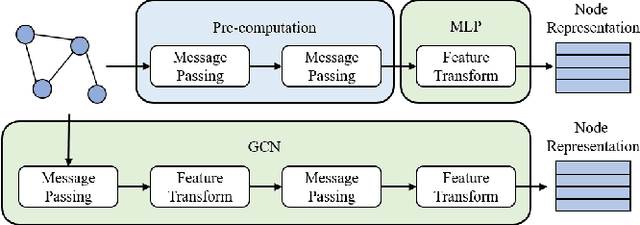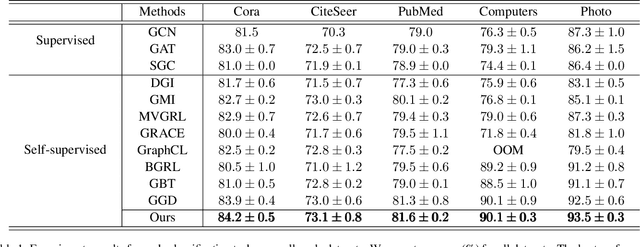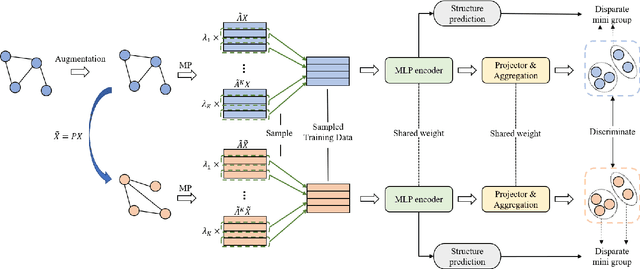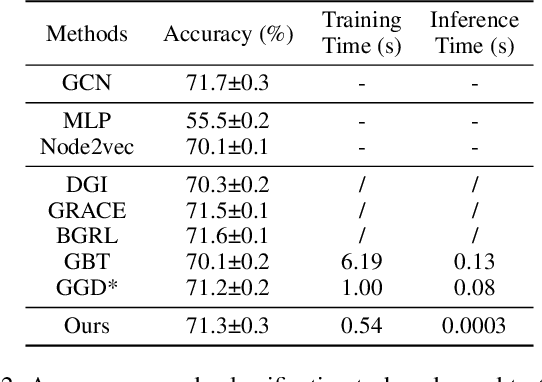Zhenshuo Zhang
GraphControl: Adding Conditional Control to Universal Graph Pre-trained Models for Graph Domain Transfer Learning
Oct 12, 2023



Abstract:Graph-structured data is ubiquitous in the world which models complex relationships between objects, enabling various Web applications. Daily influxes of unlabeled graph data on the Web offer immense potential for these applications. Graph self-supervised algorithms have achieved significant success in acquiring generic knowledge from abundant unlabeled graph data. These pre-trained models can be applied to various downstream Web applications, saving training time and improving downstream (target) performance. However, different graphs, even across seemingly similar domains, can differ significantly in terms of attribute semantics, posing difficulties, if not infeasibility, for transferring the pre-trained models to downstream tasks. Concretely speaking, for example, the additional task-specific node information in downstream tasks (specificity) is usually deliberately omitted so that the pre-trained representation (transferability) can be leveraged. The trade-off as such is termed as "transferability-specificity dilemma" in this work. To address this challenge, we introduce an innovative deployment module coined as GraphControl, motivated by ControlNet, to realize better graph domain transfer learning. Specifically, by leveraging universal structural pre-trained models and GraphControl, we align the input space across various graphs and incorporate unique characteristics of target data as conditional inputs. These conditions will be progressively integrated into the model during fine-tuning or prompt tuning through ControlNet, facilitating personalized deployment. Extensive experiments show that our method significantly enhances the adaptability of pre-trained models on target attributed datasets, achieving 1.4-3x performance gain. Furthermore, it outperforms training-from-scratch methods on target data with a comparable margin and exhibits faster convergence.
MARIO: Model Agnostic Recipe for Improving OOD Generalization of Graph Contrastive Learning
Aug 02, 2023Abstract:In this work, we investigate the problem of out-of-distribution (OOD) generalization for unsupervised learning methods on graph data. This scenario is particularly challenging because graph neural networks (GNNs) have been shown to be sensitive to distributional shifts, even when labels are available. To address this challenge, we propose a \underline{M}odel-\underline{A}gnostic \underline{R}ecipe for \underline{I}mproving \underline{O}OD generalizability of unsupervised graph contrastive learning methods, which we refer to as MARIO. MARIO introduces two principles aimed at developing distributional-shift-robust graph contrastive methods to overcome the limitations of existing frameworks: (i) Information Bottleneck (IB) principle for achieving generalizable representations and (ii) Invariant principle that incorporates adversarial data augmentation to obtain invariant representations. To the best of our knowledge, this is the first work that investigates the OOD generalization problem of graph contrastive learning, with a specific focus on node-level tasks. Through extensive experiments, we demonstrate that our method achieves state-of-the-art performance on the OOD test set, while maintaining comparable performance on the in-distribution test set when compared to existing approaches. The source code for our method can be found at: https://github.com/ZhuYun97/MARIO
Structure-Aware Group Discrimination with Adaptive-View Graph Encoder: A Fast Graph Contrastive Learning Framework
Mar 09, 2023



Abstract:Albeit having gained significant progress lately, large-scale graph representation learning remains expensive to train and deploy for two main reasons: (i) the repetitive computation of multi-hop message passing and non-linearity in graph neural networks (GNNs); (ii) the computational cost of complex pairwise contrastive learning loss. Two main contributions are made in this paper targeting this twofold challenge: we first propose an adaptive-view graph neural encoder (AVGE) with a limited number of message passing to accelerate the forward pass computation, and then we propose a structure-aware group discrimination (SAGD) loss in our framework which avoids inefficient pairwise loss computing in most common GCL and improves the performance of the simple group discrimination. By the framework proposed, we manage to bring down the training and inference cost on various large-scale datasets by a significant margin (250x faster inference time) without loss of the downstream-task performance.
 Add to Chrome
Add to Chrome Add to Firefox
Add to Firefox Add to Edge
Add to Edge